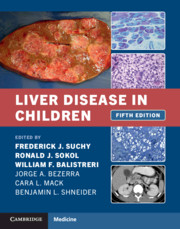Book contents
- Liver Disease in Children
- Liver Disease in Children
- Copyright page
- Contents
- Contributors
- Preface
- Section I Pathophysiology of Pediatric Liver Disease
- Chapter 1 Liver Development
- Chapter 2 Functional Development of the Liver
- Chapter 3 Mechanisms of Bile Formation and the Pathogenesis of Cholestasis
- Chapter 4 Acute Liver Failure in Children
- Chapter 5 Cirrhosis and Chronic Liver Failure in Children
- Chapter 6 Portal Hypertension in Children
- Chapter 7 Laboratory Assessment of Liver Function and Injury in Children
- Section II Cholestatic Liver Disease
- Section III Hepatitis and Immune Disorders
- Section IV Metabolic Liver Disease
- Section V Other Considerations and Issues in Pediatric Hepatology
- Index
- References
Chapter 4 - Acute Liver Failure in Children
from Section I - Pathophysiology of Pediatric Liver Disease
Published online by Cambridge University Press: 19 January 2021
- Liver Disease in Children
- Liver Disease in Children
- Copyright page
- Contents
- Contributors
- Preface
- Section I Pathophysiology of Pediatric Liver Disease
- Chapter 1 Liver Development
- Chapter 2 Functional Development of the Liver
- Chapter 3 Mechanisms of Bile Formation and the Pathogenesis of Cholestasis
- Chapter 4 Acute Liver Failure in Children
- Chapter 5 Cirrhosis and Chronic Liver Failure in Children
- Chapter 6 Portal Hypertension in Children
- Chapter 7 Laboratory Assessment of Liver Function and Injury in Children
- Section II Cholestatic Liver Disease
- Section III Hepatitis and Immune Disorders
- Section IV Metabolic Liver Disease
- Section V Other Considerations and Issues in Pediatric Hepatology
- Index
- References
Summary
Pediatric acute liver failure (PALF) is not a single diagnosis. Rather, PALF is a complex, rapidly progressive clinical syndrome that is the final common pathway for many disparate conditions; some known and others yet to be identified [1, 2]. The estimated frequency of acute liver failure (ALF) in all age groups in the USA is about 17 cases per 100,000 population per year, but the frequency in children is unknown. In the USA, ALF accounts for 10–15% of pediatric liver transplants performed annually [3]. Management requires a multidisciplinary team involving the hepatologist, critical care specialist, and liver transplant surgeon. Acute liver failure is a rapidly evolving clinical condition. The absence of adequately powered studies to inform diagnostic algorithms, to assess markers of disease severity and trajectory, and to guide liver transplant decisions transfers a significant burden to the clinician. Constructing a diagnostic approach and individualized management strategy that may include the decision to pursue liver transplantation is challenging. There are a number of pressing clinical questions faced when children with PALF first present. Does the patient have a condition that is treatable? What is the risk of deterioration or improvement on each day the child is alive with his/her native liver? Is a living related or deceased liver transplant necessary for patient survival? Is full recovery possible without a liver transplant? Are associated morbidities recoverable or irreversible?
- Type
- Chapter
- Information
- Liver Disease in Children , pp. 36 - 57Publisher: Cambridge University PressPrint publication year: 2021

